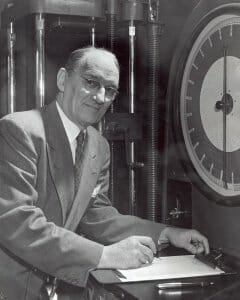Chipping the Old, Old, Old Block
A century-old UW experiment tests how long concrete lasts.

In 1910, Withey created a collection of concrete cylinders, set them aside to age, and then crushed them. UW Archives
What might be the UW’s oldest experiment will end this summer, when Professor Emeritus Steve Cramer ’79 smashes the last of several century-old blocks of concrete. Once he does, he’ll bring an end not only to the long-running project but also to his career-long fascination with the construction material.
“I was in the last undergraduate concrete technology course taught by Professor George Washa ’30, MS’32, PhD’38, and I was amazed at his instruction,” Cramer says. “He came down into the laboratory, and here was this distinguished old gentleman. He reached down, and he grabbed a handful of concrete. For me, he brought it to life.”
This particular study began in 1910, when engineering instructor Owen Withey took an interest in the technology underlying concrete. “Professor Withey jumped on this as a new material and started to ask questions about it, about the longevity, and he created a tradition then of being at the leading edge of this material,” says Cramer.
Withey wanted to know how long concrete would last, and so he created a collection of six-inch-wide, 12-inch-long cylinders, and then he put them aside to age. He repeated the process in 1923 and again in 1937. At various intervals, he would take some of the cylinders, put them in a hydraulic press, and apply pressure until they broke.
“These old, dry cylinders either crumble or explode,” Cramer says. “It’s a rather modest explosion, but there’ll be a little bit of a bang, they’ll fall apart, and the test will stop.”
When Withey retired in 1953, he passed the experiment to another faculty member, who passed it on to another, each concrete specialist often choosing a former student as the heir to the experiment. Washa studied under Withey long before he inspired Cramer, who took over after he joined the faculty in 1984.
Cramer, Washa, and others destroyed the last of the 1937 batch on its 50th anniversary, in 1987, and his lab crushed the last of the 1910 cylinders at their centennial in 2010. Although Cramer retired in 2021, he means to see the experiment to its conclusion. When he watches the 1923 batch get smashed this summer, that will be the end of Withey’s concrete — and the results, you might say, will be set in stone.
“One thing led to another,” says Cramer. “Younger students don’t quite understand. They often think they plan their career, but relationships and things happen that lead you on the path if you’re open to that path.”
Published in the Summer 2023 issue



Comments
John August 4, 2023
…and the results over 100 years show that concrete…?